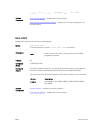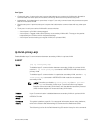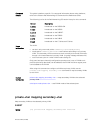
Port Types:
• Community port: A community port is a port that belongs to a community VLAN and is allowed to
communicate with other ports in the same community VLAN and with promiscuous ports.
• Isolated port: An isolated port is a port that, in Layer 2, can only communicate with promiscuous ports
that are in the same PVLAN.
• Promiscuous port: A promiscuous port is a port that is allowed to communicate with any other port
type.
• Trunk port: A trunk port carries VLAN traffic across switches:
– A trunk port in a PVLAN is always tagged.
– A trunk port in Tagged mode carries primary or secondary VLAN traffic. The tag on the packet
helps identify the VLAN to which the packet belongs.
– A trunk port can also belong to a regular VLAN (non-private VLAN).
ip local-proxy-arp
Enable/disable Layer 3 communication between secondary VLANs in a private VLAN.
S4820T
Syntax
[no] ip local-proxy-arp
To disable Layer 3 communication between secondary VLANs in a private VLAN,
use the no ip local-proxy-arp command in INTERFACE VLAN mode for the
primary VLAN.
To disable Layer 3 communication in a particular secondary VLAN, use the no ip
local-proxy-arp command in INTERFACE VLAN mode for the selected
secondary VLAN.
NOTE: Even after you disable ip-local-proxy-arp (use no ip-local-
proxy-arp) in a secondary VLAN, Layer 3 communication may happen
between some secondary VLAN hosts, until the address resolution protocol
(ARP) timeout happens on those secondary VLAN hosts.
Defaults Layer 3 communication is disabled between secondary VLANs in a private VLAN.
Command
Modes
INTERFACE VLAN
Command
History
This guide is platform-specific. For command information about other platforms,
refer to the relevant Dell Networking OS Command Line Reference Guide.
The following is a list of the Dell Networking OS version history for this command.
Private VLAN (PVLAN)
1435


















